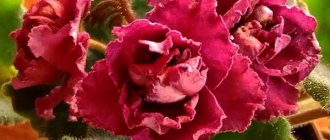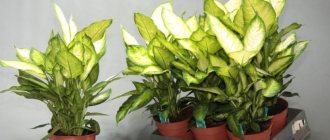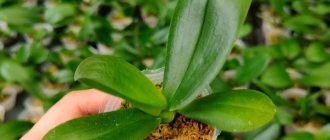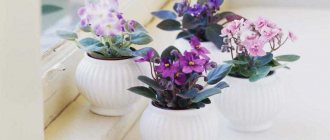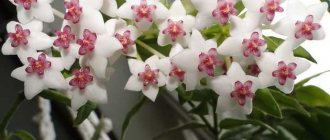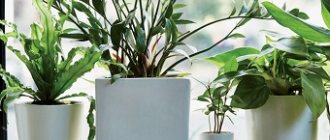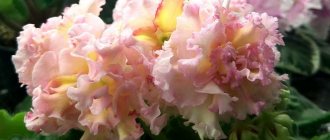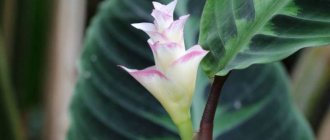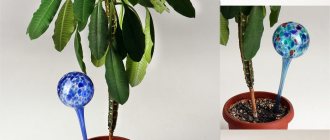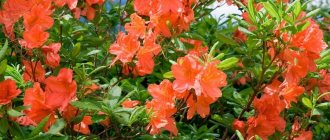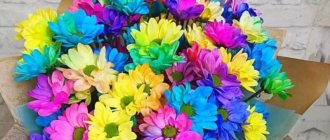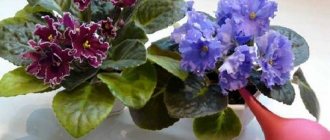You can confess your love without buying luxurious bouquets, which, at best, will go in the trash in a week. Houseplants, no worse than cut flowers, can tell about the feelings of the person who gave them. Girls will truly appreciate them, because with proper care, these green pets will delight their owner for years.
Hoya Kerry
Hoya Kerry is rightfully considered one of the most romantic plants, because its leaves are heart-shaped. Caring for this succulent is simple and even an inexperienced plant grower can handle it. And hoya will reward those who are especially patient with fragrant flowers resembling stars.
Rumor has endowed it with magical properties: hoya connects the masculine and feminine principles and brings peace and harmony to the house. The caramel smell that spreads during the flowering period may be too strong only for people with allergies. And hoya is not only pleasing to the eye and soothing - the juice of its leaves can be used as a remedy for treating boils.
Anthurium
The next participant in this collection has heart-shaped flowers, not leaves. This anthurium, or as it is popularly called, “male happiness,” is a very beautiful and bright indoor plant. It can bloom in both summer and winter. Its flowers, even cut ones, can remain fresh for up to two weeks.
Red anthurium is often purchased for Valentine's Day, its glossy red flowers and equally shiny dark green leaves provide a wonderful contrast and look very impressive. In addition, it brings its owner success in business: from work to love, gives him self-confidence, improves his mood, and relieves fatigue. This flower is ideal for those born under the sign of Leo; it can be their patron and talisman.
Landing dicenters
It is advisable to begin preparing the soil for planting this crop before the onset of winter. Dicentra is unpretentious and feels great in almost any soil, but dicentra grows best in fertile and slightly acidic soils. The plant does not tolerate excess moisture. For a comfortable existence of the flower, it is recommended to equip the planting site with drainage consisting of gravel, pebbles, expanded clay or broken brick.
The earth is dug up to a depth of no more than ten cm. Humus is added during the digging. The amount of organic fertilizer is determined based on the calculation of five kg per 1 sq.m. It is also recommended to improve the soil with mineral fertilizers (20 grams per square meter). Before planting, which takes place in the fall, the soil is prepared 4-5 weeks in advance.
Planting in open ground begins in early spring.
Caladium
Caladium, unlike its predecessor, blooms for a very limited period of time. But to be beautiful, he doesn’t have to do this at all. It takes revenge with its unusual decorative leaves, which can be white, green and even red or burgundy. For their amazing beauty, the plant is called “angel wings”, “elephant ears” and “heart of Jesus”.
This handsome man is quite capricious, but for the sake of his gorgeous leaves, you can try to provide him with the best care.
Varieties
There are a considerable number of types of “broken heart”, each variety differs in color, flower diameter, flowering duration, etc. Below are the most popular varieties:
- Dee or "White". A relatively low plant, grows up to 70 cm. The petioles are quite long, up to 15 cm. The white color of the heart-shaped bud is a feature of this variety. The inflorescence is white with yellow stamens. Small flowers, the diameter of which does not exceed two centimeters, form flowing brushes up to 20 cm long. The main number of leaves is usually located closer to the base of the stem. Leaves are pubescent, double-triple or triple pinnately dissected. Alba is characterized by long flowering, which lasts from May to mid-July.
Dicentra white - Low-growing Dicentra Magnificent variety "Gold Heart" - a hybrid introduced by breeders in 2004, is a spreading bush, the height of which does not exceed 60 cm. Many small yellowish variegated leaves cover the bush with thick pink stems. Pink and white flowers reach 4 cm in diameter, collected in long racemes (15–20 cm). Compared to other varieties, it blooms for less time, about 20 days in May - June.
Variety "GoldHart" - Tall liana-like perennial - Di. A huge bush 2–2.5 m high. Small light green leaves scatter the petioles in large quantities. The flowers are bright, yellow, large, up to 5 cm in diameter. The brushes are replete with a huge number of buds and flowers. Abundant flowering continues from May until frost, but begins only the next year after planting in the ground.
Variety "Golden Vine" - Dicentra Valentina is distinguished by its double coloring of flowers. Red above, white below. The height of this perennial frost-resistant plant is 65–70 cm. Spreading arched shoots allow you to form a beautifully shaped bush with an average size of 50x75. The twenty-centimeter petioles are decorated with an abundance of large feathery leaves of an ash-green hue. The burgundy color of the stems adds its own flavor. The flowers are not particularly large, about 4 cm in diameter, collected in long racemes (15–20 cm). Flowering begins in May and lasts about 30 days.
Dicentra Valentina
Philodendron
Philodendron also features shiny, heart-shaped leaves. This vine tends to grow luxuriantly: a lot of hearts going down the wall look very beautiful.
Like the rest of the plants from this collection, it has positive energy that has a good influence on its owner, her relationships with others, especially with the man who gave the plant.
Alocasia
Alocasia is an original evergreen houseplant. Its leaves also have the shape of hearts, but, unlike the previous ones, it is not quite ordinary, but carved.
The plant is unpretentious in care; it is often grown in apartments and offices. However, alocasia rarely blooms under these conditions, especially if the conditions are very different from natural ones. Its flowers look like candles.
LiveInternetLiveInternet
Hi all. Yesterday I went to the flower market, I wanted to buy a dieffenbachia bush, with huge green leaves, unfortunately, this time there was no such plant, but I noticed a completely different plant. As you guessed, the plant is guzmania and today I will tell you what kind of care it needs at home. At first glance it may seem that the plant is picky and needs to be given a lot of attention, but in reality everything is simpler. I admit, at first, when I read about this plant, I was a little scared, because it seemed to me that I couldn’t cope with it, and the flower would soon disappear.
And it’s not surprising that she was scared. Humania must be watered carefully, otherwise the roots may rot and the plant will disappear. And you need to water not as usual, in the pot, but in the outlet. The whole point is that guzmania came to us from South American forests, where precipitation falls constantly, where the dry period lasts a short time (in winter). This plant is very similar to orchids, since the guzmania orchid grows on tree branches. In such conditions, the roots of Guzmania do not develop very well, and they rather play a fixative function, and are practically not adapted to obtain food for themselves from the ground.
But despite this, in nature guzmania receives everything it needs from the precipitation that collects in its rosette of leaves. It was this information that stopped me from buying the plant, since I thought it would be very difficult to create such care at home.
It is a little difficult to provide good lighting for the plant. Guzmania loves it when it is very light, but at the same time it does not tolerate direct sunlight.
Indoor guzmania flower: care at home
From the above it can be understood that the roots are the most vulnerable place of the plant. And the slightest mistake in care can lead to the death of the plant. So it is important to choose the right soil. As for the land for planting, it is important to choose light soil that allows air to pass through. You can prepare the soil yourself from a mixture of turf soil, sand and fibrous peat (1:1:2), you can also add charcoal. Or you can buy moss (sphagnum) and some tree bark of coniferous trees (1:3). But you don’t have to worry and buy ready-made soil for orchids.
I mentioned above that the roots practically do not provide the plant with nutrients, therefore, there is no need to purchase deep dishes for planting. Another reason you should not use deep pots is that it will make it difficult to observe the root system, so do not take deep containers (about 12 cm). Before planting guzmania, the pot must be filled with drainage to 1/3; the guzmania is replanted using the transshipment method, so as not to damage the root system. Also, do not compact the soil with your hands; in order for the soil to shrink, you can lightly tap the pot. Make sure that the neck of the plant remains above the soil level; under no circumstances should it be covered with soil.
Temperature and humidity
Well, everything is clear here. You need to try to create conditions at home that are similar to natural ones, or rather: high temperature and high humidity. If things are easier with temperature, since city apartments are almost always warm, but with humidity it’s more complicated. I don’t know about you, but in our houses during the heating season the air is very dry. So you will have to try hard with humidity. To provide Guzmania with high humidity, the plant must be sprayed several times; you can place a plate with wet sand or just water next to the indoor flower.
Some gardeners grow Guzmania in aquariums or glass containers, which helps provide the plant with maximum moisture. In addition to providing the plant with moisture, keeping it in an aquarium gives it a magnificent and unusual appearance; in general, this picture looks very beautiful. But unfortunately, not every gardener can afford such luxury.
You should not take the plant outside in the summer; it is especially important to protect the plant from drafts, but it is necessary to ventilate the room. You can take the guzmania out to the balcony, but on the condition that it will not be exposed to direct sunlight.
Lighting
The plant loves when there is a lot of light, but does not like direct sunlight, so in the summer it is better to place it at some distance from the window if it faces south. If this is not possible, then you will have to shade the windows with something; we have blinds on the windows, which is very helpful in saving plants from burns in the summer.
In winter, there is naturally not enough light. But the plant tolerates a lack of light normally, the only thing is that it can affect the decorative appearance of the plant. Due to lack of light, all parts of the guzmania become dark green. So the set is needed to create a decorative look for the plant.
Watering Guzmania at home
Many gardeners make the mistake of watering a plant in a pot, which can cause the death of the plant. Water should be poured not into the pot, but into the rosette of leaves. It is necessary to ensure that there is always water in the sockets, but it must be renewed periodically, that is, completely pour out the old water and pour in new water. At low temperatures, less than 20C, it is better not to pour water into sockets to avoid rotting of the leaves. During this period, you can water the plant in the pot, but moderately, and only when the top layer of soil is completely dry.
Guzmnasia is not demanding when it comes to fertilizing at home. Indeed, in natural conditions it receives very few nutrients. And at home, fertilizing is important only to prolong the decorative flowering of the plant. But it is important not to overdo it with fertilizing, so you need to dilute fertilizers several times less than what is written in the instructions. Plants are fed by watering into a socket, or by spraying.
Reproduction of Guzmania at home
Many gardeners are afraid that after flowering guzmania disappears. I would like to note that this is a natural process, so you should not be afraid. But, instead of one guzmania, you can get several plants. The thing is that the mother plant produces several children until it dries out.
When you notice that the tips of the upper leaves of the bract begin to dry out, move the plant to the shade to stimulate it to produce children. If you want to speed up the process, the peduncle can be removed. At this time, you should stop watering the outlets; you need to water a little into the pot after the top layer has dried. When the baby reaches half the height of the mother plant, it is carefully cut with a knife and planted in a container with soil for bromeliads (orchids).
If you create all the necessary conditions (high humidity, temperature), then the children can bloom in a year, but in most cases, at home, guzmania blooms in 4-5 years. After you have cut the baby from the mother plant, do not rush to throw it away, since after separation, more babies may appear, albeit weaker ones. The last batch of babies can not be separated and left on the mother plant. In this case, the children grow stronger and may even outgrow their older brothers (previously separated children).
If young guzmanias have not bloomed for 2-3 years, they are transplanted into a new substrate. And with flowering plants, carry out the same actions as described above.
Care problems
- With any violation of care, guzmania dies at home. If there is overwatering, you should not even try to save the plant by replanting, as this will not help.
- Guzmania is not protected from pest attacks (scale insects, mites, mealybugs). When attacked by pests, the leaves of the plant begin to die. If there are few pests, then you can wipe the leaves with soapy water; if the disease is advanced, you will have to resort to the help of special preparations.
- If the tips of the leaves become dry and brown, this indicates a lack of moisture. In this case, you need to provide the plant with air humidity by frequent spraying.
- If brown spots appear on the leaves, this indicates burns. You will have to remove the plant from the window, away from sunlight.
- Has a white limescale coating appeared on the leaves? This means that the water for irrigation is too hard.
- Your guzmania has bloomed, but there are no children? Move the plant into the shade and cut off the flower stalk.
- If the leaves become limp and the funnel rots, congratulations, your plant is dying, as these symptoms indicate rotting of the root system. Unfortunately, the plant cannot be saved.
https://delniesoveti.ru/guzmaniya-uhod-v-domashnih-usloviyah/
